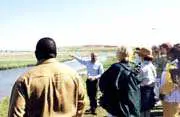Driving along the New Jersey Turnpike in the early 1980s, people could see thousands of seagulls floating above open pits of trash that made up the heart of the Meadowlands district. Although the process had started to clean up and contain the trash, many of the species of animals and plants already had declined to a precariously low level. “Gulls are opportunistic creatures,” said Anne Galli, director of the Hackensack Meadowlands Development Commission’s Environmental Center, recently. “Gulls will feed on anything, even junk from landfills.” Vast parts of the Meadowlands were dumps for trash. In the early 1960s, four million tons of trash were dumped here per week, even though the 7,000 acres of the wetlands along the Hackensack River provided a critical stopover and feeding ground for many thousands of migratory birds along the Atlantic flyway. The water here also provided a nursery for three-quarters of the fish caught by Mid-Atlantic commercial fishing fleets. But pollution, trash, and development in the area began to kill off or drive away the creatures, reducing the level of species found in the Meadowlands from about 200 in the 19th Century to about 13 by the mid-1960s. Over the last two decades, however, the Hackensack River has made a remarkable comeback, rising from an all-time low of 13 resident species to about 43 with many more migratory species stopping in the area in various seasons. Some species, according to Wild Life New Jersey, have returned to the Meadowlands that have not been seen here since the 1920s. “Long maligned as the handmaiden of the Meadowlands landowners and developers, the HMDC has nonetheless effected the closure and sealing of active landfills in the Meadowlands District, enforced water quality regulations, and developed recreation resources in the Meadowlands,” said John Quinn, author of Fields of Sun and Grass, An Artist’s Journal of the New Jersey Meadowlands, who is now on the staff at the HMDC. “One of the areas where the recovery is most visible to the average person is right here around the Environmental Center in Lyndhurst,” said Galli. That was at the Kingsland Overlook site, right near HMDC headquarters, a six-acre area in which the HMDC conducted a pilot study during the early 1990s. For the study, they created a series of mini-habitats from open field to young forest where birds and other creatures might find home. “Prior to our setting up the pilot, that land was largely occupied by sea gulls, starlings and pigeons” Galli said. Now, warblers and other birds have settled into the area, along with the associated insects, fish, plants and other elements that originally made the area so attractive to so many species. “This is only a small example,” Galli said. “What we’re trying to do it use it as a model and project it to a global scale. What we’re talking about is habitat preservation around the world, building a biodiversity so that birds, fish, insects and trees work together.” Biodiversity is shorthand for biological diversity, the variety of life on Earth. It means all life forms -from the smallest bacterium to the largest trees-the totality of all the different. But the earth is now losing species at a rate about 1,000 times faster than normal-faster even than the “great extinction” of the dinosaurs. The loss can occurs because of natural events such as change of climate or through human activities such as development. Scientists studying loss of species in Canada claim that development has caused a 50 percent decline of songbirds in the Middle Atlantic states since 1950, placed 680 plant species at risk in North America, and caused about 20 percent of the world’s freshwater fish species to be either extinct or in steep decline. The accelerating loss of biodiversity worldwide over the past five decades is considered one of the greatest threats that will confront humanity in the coming century. International conference examines successes The Kingsland Overlook and several other pilot sites around the Meadowlands became the subject of an international workshop on biodiversity held in May at the Environmental Center. Forty museum educators and schoolteachers from the United States and Canada gathered to examine some of the success stories in the Meadowlands and how they might be applied to other parts of the planet. In welcoming the group to the Environment Center, Galli and Supervisor of Educational Programs Cory Ogden noted that the Meadowlands District can be seen as a habitat that suffered a great loss of biodiversity due to urbanization, pollution and unregulated waste disposal, but which has “made a remarkable comeback in the past 30 years due to successful efforts on the part of the HMDC to close and cap landfills, enhance wetlands, and clean up water pollution,” according to Ogden. Participants observed techniques and educational approaches at the symposium that they can take back to their respective institutions for adaptation into their own environmental science programs and public outreach. In the beginning of the program, HMDC wetlands specialists Ken Scarlatelli and Judy Burton escorted the group to sites in North Arlington and Secaucus where gulls, egrets and shorebirds were in abundance, including four endangered black skimmers spotted lounging on a mud flat. HMDC landscape architects Katy Weidel, Lisa Cameron, and Joanne DiLorenzo wrapped up the outdoor sessions with tours of the three-acre Lyndhurst Nature Reserve and the Kingsland Overlook in the Richard W. DeKorte Park, site of the HMDC’s headquarters in Lyndhurst. Both small natural areas were designed and developed as part of the DeKorte Park master plan in 1981 and are situated on capped and remediated landfills. Ultimately, nearly 9,000 acres of wetlands in the District will be enhanced and returned to a functioning state and then opened to the public as an educational and recreational resource, Weidel said.
Our Digital Archive from 2000 – 2016
